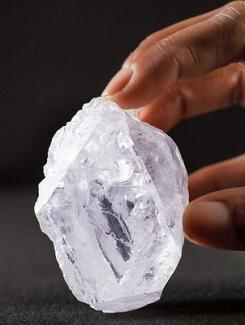Where silver always beats gold!

10/05/2017
Updated on 10/08/2018

A little over a week ago, the Lesedi La Rona diamond, the second-biggest gem-quality* diamond ever found, sold for a whopping $53 million. Well, whopping is a relative term here, just a few years prior the diamond had failed to sell at auction when nobody was willing to meet the opening bid price, which Sotheby’s had set at $70 million. At 1,109-carats (about a half pound or .22 kilos for those of us who don’t deal in carats as our everyday go-to unit of measurement) the Lesedi La Rona is second only to the 3,106-carat Cullinan diamond, which was discovered in 1905 and had since been cut up into smaller stones, the biggest of which adorns Britain’s royal scepter as part of the Crown Jewels.
The Lesedi La Rona, which in the Twsana language means “Our Light”, was found in the Karowe mine in Botswana in 2015. So big was the stone that it couldn’t fit into conventional gem scanners, which are computer-aided machines used to determine a stone’s overall worth. You can’t fault the diamond industry for that one — only about once in a century do you get a tennis-ball-sized diamond popping out of the ground. These scanners are important for diamond cutters because a stone’s value is not based solely on its size, but also on its color, and the non-presence of any flaws or cracks. They also help cutters determine how best they can cut the diamond into either a bunch of smaller diamonds or shaped into one big gigantic polished stone, which in turn determines the amount of money they can get out of the rough diamond. Of course, this information served more as a fantastic publicity story rather than an actual problem, it did however compel Lucara, the company that owned the mine where the diamond was found, to use more old-fashioned and conventional methods to determine its worth. This means they had to have human experts in Antwerp, Belgium — sort of the Detroit of the diamond trade — use their experience and eyes to determine the stone’s value.

The Karowe Mine in Botswana where the Lesedi la Rona was found.
The Vancouver-based Lucara bought a controlling stake in the Botswana diamond mine in 2009 from de Beers, the company that basically created and inflated the whole diamond market. Their investment of $49 million to get the mine seems to have paid off nicely. It paid off for the country as a whole as well — Botswana levies a 10% export tax on minerals found there, in addition to a 10% royalty on all gems mined there. Not a bad haul for the South African country.
The company that paid $53 million for the stone was Graff Diamonds, a London-based international jewell supplier.
*Bigger rough diamonds have been found, but they weren’t considered “gem quality” as they had flaws that made them less appealing.